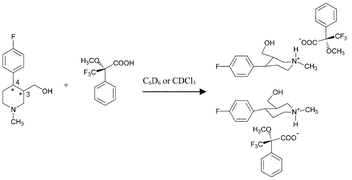Enantiodiscrimination in NMR spectra and X-ray structures of diastereomeric salts of trans-4-(4-fluorophenyl)-3-hydroxymethyl-1-methylpiperidine with (S)-Mosher acid
Abstract
Signal anisochrony (Δδ) in

* Corresponding authors
a
Department of Organic Chemistry, Faculty of Science, Masaryk University, Kotlářská 2, 611 37 Brno, Czech Republic
E-mail:
hanavra@chemi.muni.cz
Fax: 420 5 411 29 641
Tel: 420 5 411 29 311
b
Crystallography Laboratory, Department of Inorganic Chemistry, Faculty of Science, University of Nijmegen, Toernooiveld 1, Nijmegen, 6525 ED, The Netherlands
E-mail:
rdg@sci.kun.nl
c
National Centre for Biomolecular Research, Faculty of Science, Masaryk University, Kotlářská 2, 611 37 Brno, Czech Republic
E-mail:
zdenek@ncbr.chemi.muni.cz
Signal anisochrony (Δδ) in

 Please wait while we load your content...
Something went wrong. Try again?
Please wait while we load your content...
Something went wrong. Try again?
H. Navrátilová, R. D. Gelder and Z. Kříž, J. Chem. Soc., Perkin Trans. 2, 2002, 2093 DOI: 10.1039/B207176B
To request permission to reproduce material from this article, please go to the Copyright Clearance Center request page.
If you are an author contributing to an RSC publication, you do not need to request permission provided correct acknowledgement is given.
If you are the author of this article, you do not need to request permission to reproduce figures and diagrams provided correct acknowledgement is given. If you want to reproduce the whole article in a third-party publication (excluding your thesis/dissertation for which permission is not required) please go to the Copyright Clearance Center request page.
Read more about how to correctly acknowledge RSC content.
 Fetching data from CrossRef.
Fetching data from CrossRef.
This may take some time to load.
Loading related content
